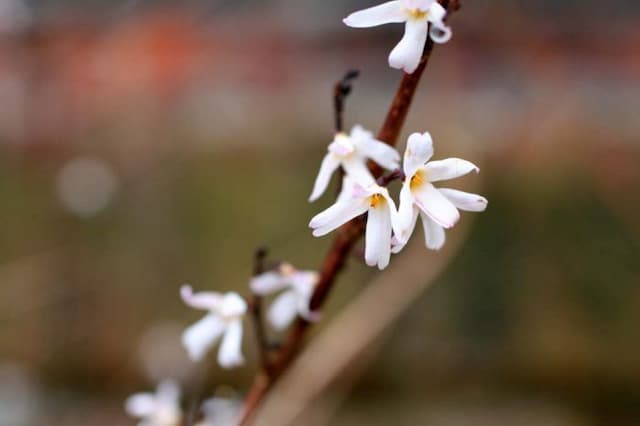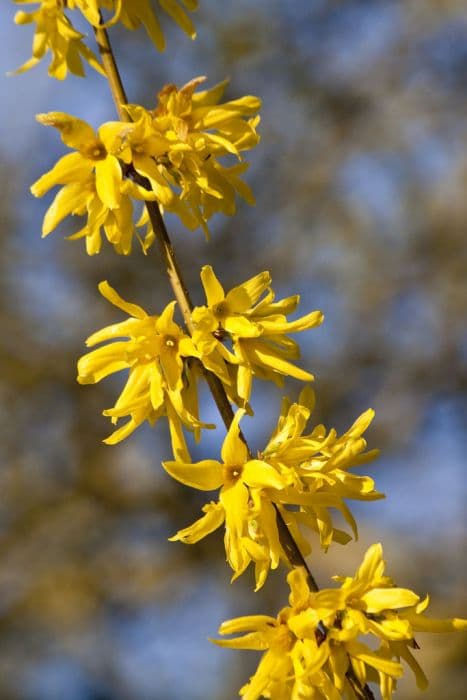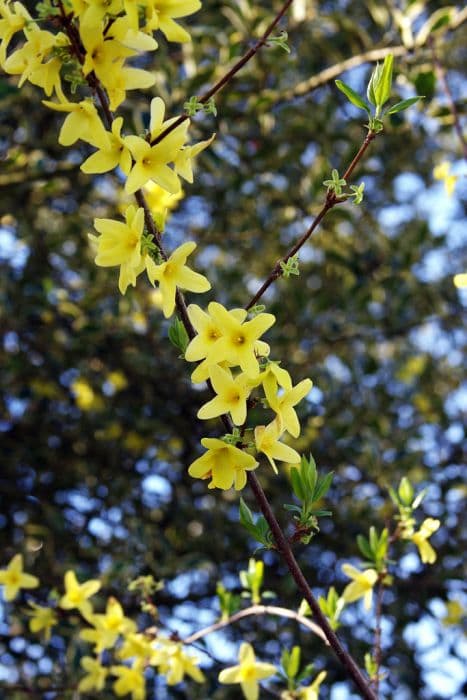Lynwood Gold Forsythia Forsythia × intermedia 'Lynwood Variety'

ABOUT
The Lynwood Variety of forsythia is a vibrant and eye-catching flowering shrub that's renowned for its profusion of brilliant yellow blossoms. These flowers are particularly striking as they typically emerge before the foliage does in early spring, covering the branches in a bright cloak of color. Each blossom is trumpet-shaped and grouped in clusters, creating a dense and cheerful display against the still-bare branches from which they sprout. The leaves of the Lynwood Variety appear after the flowering period, offering a lush, dark green backdrop that contrasts nicely with the floral display. These leaves are oval-shaped with a slightly toothed edge, lending a fine texture to the plant. As the seasons change, the foliage can change color, adding another layer of interest to the shrub. While the flowers are the main attractant, the plant's form is also notable. It has a natural, somewhat upright and arching growth habit, which allows it to create a pleasing shape in the landscape without needing extensive pruning or care. The branches themselves are slender and may be somewhat angular, contributing to the overall visual interest of the Lynwood Variety forsythia. With its vivid blooms and attractive foliage, this plant is a popular choice for adding a splash of color to gardens, especially as an early sign of spring.
About this plant
 Names
NamesFamily
Oleaceae
Synonyms
Lynwood Gold Forsythia, Lynwood Variety Forsythia, Border Forsythia
Common names
Forsythia × intermedia 'Lynwood Variety'
 Toxicity
ToxicityTo humans
Forsythia, including the 'Lynwood Variety', is generally considered non-toxic to humans. Therefore, ingesting parts of this plant typically does not result in poisoning or adverse symptoms. However, it is always advisable to discourage children from eating any non-food plants due to the potential for unforeseen allergies or reactions.
To pets
Forsythia, also for the 'Lynwood Variety', is typically regarded as non-toxic to pets. Consuming parts of this plant is not known to cause any significant symptoms of poisoning in animals like dogs and cats. However, ingestion in large quantities might sometimes cause mild gastrointestinal upset such as vomiting or diarrhea. It is always prudent to keep an eye on pets and prevent them from eating large amounts of any plants, as individual reactions can vary.
 Characteristics
CharacteristicsLife cycle
Perennials
Foliage type
Deciduous
Color of leaves
Green
Flower color
Yellow
Height
7-10 feet (2.1-3 meters)
Spread
7-10 feet (2.1-3 meters)
Plant type
Shrub
Hardiness zones
5-8
Native area
Europe Asia
Benefits
 General Benefits
General Benefits- Early Spring Bloom: Forsythia x intermedia 'Lynwood Variety' is known for its vibrant yellow flowers that bloom in early spring, providing a burst of color after the winter months.
- Attracts Pollinators: The bright flowers serve as an early food source for bees and other pollinators, supporting local ecosystems.
- Landscape Design: With its arching branches and bright flowers, it is commonly used in landscape designs for hedging, borders, and as a focal point in gardens.
- Low Maintenance: This plant is relatively low maintenance, requiring minimal care once established and is adaptable to a range of soil conditions.
- Fast Growth: It has a fast growth rate, which can quickly fill spaces in garden designs and create privacy screens or hedges.
- Drought Tolerant: Once established, it has good drought tolerance, reducing the need for watering in periods of low rainfall.
- Tolerates Urban Pollution: It can tolerate urban conditions well, including pollutants and poor soils, making it suitable for city landscapes.
 Medical Properties
Medical PropertiesThis plant is not used for medical purposes.
 Air-purifying Qualities
Air-purifying QualitiesThis plant is not specifically known for air purifying qualities.
 Other Uses
Other Uses- Forsythia branches can be used as a natural dye for fabrics, yielding a range of beautiful yellows depending on the mordant used.
- The stems of forsythia can be hollowed out and used as organic drinking straws or for crafting purposes.
- When forsythia is in bloom, its flowers can add a bright, edible garnish to salads and desserts.
- The woody stems of forsythia can be fashioned into small stakes for supporting indoor plants or marking rows in a garden.
- Forsythia plant can be used in floral arrangements, particularly as a harbinger of spring when forced to bloom early indoors.
- With its spring display, forsythia can be used as a living seasonal barometer to indicate the arrival of spring gardening activities.
- The dense foliage of forsythia can provide a privacy screen or windbreak when planted in a row or hedge.
- Forsythia is sometimes used to stabilize slopes or control erosion due to its robust root system.
- The fast-growing nature of forsythia makes it suitable for use as a quick hedge or filler plant in landscape design.
- Cut forsythia branches can be used in children's crafts, such as magic wands or fairy garden accessories, because of their interesting shape and sturdy nature.
Interesting Facts
 Feng Shui
Feng ShuiThe Forsythia is not used in Feng Shui practice.
 Zodiac Sign Compitability
Zodiac Sign CompitabilityThe Forsythia is not used in astrology practice.
 Plant Symbolism
Plant Symbolism- Anticipation: Forsythias often bloom early in spring, signaling the end of winter and the anticipation of warmer weather, making them a symbol of looking forward to something.
- Joy: With their bright, cheerful yellow flowers, forsythias are commonly associated with happiness and the joyfulness of spring's arrival.
- Renewal: As one of the first plants to bloom in spring, forsythias symbolize renewal and the start of a fresh cycle in nature.
 Water
WaterThe Lynwood Gold Forsythia should be watered deeply once a week, providing the soil enough moisture to encourage deep root growth. In the first growing season, it's essential to establish a good root system, so consistent watering is critical; typically, around 2 gallons per week depending on weather conditions. Once established, Lynwood Gold Forsythia is quite drought tolerant, but during prolonged dry spells, it may need additional water. Always check the soil moisture several inches down; if the soil feels dry, it's time to water again. Over-watering can be detrimental, so ensure proper drainage and do not let the plant sit in soggy soil.
 Light
LightLynwood Gold Forsythia thrives best in full sun to partial shade. An ideal spot is one where it can bask in at least six hours of sunlight daily, which encourages prolific blooming. However, this plant can tolerate light shade, but flowering may be less abundant in these conditions.
 Temperature
TemperatureThe Lynwood Gold Forsythia is hardy and can tolerate a wide range of temperatures, flourishing in zones 5-8. It can withstand winter lows down to -20°F and is generally unfazed by summer highs as long as it receives adequate water during extreme heat. The ideal temperature range for this plant is between 60°F to 75°F for optimal growth and flowering.
 Pruning
PruningPruning Lynwood Gold Forsythia is necessary to maintain its shape and encourage vigorous growth. The best time to prune is just after the plant finishes blooming in the spring, as it flowers on the previous year's growth. Remove any dead or damaged branches and thin out older stems to allow light into the center of the shrub. Typically, pruning once a year is sufficient to keep the plant healthy and well-shaped.
 Cleaning
CleaningAs needed
 Soil
SoilThe Lynwood Gold Forsythia thrives in well-draining soil with a generous amount of organic matter. A balanced mix, comprising equal parts loam, peat, and perlite or sand, provides the ideal texture and nutrients. The soil pH should be slightly acidic to neutral, ranging from 6.0 to 7.0, for optimal growth.
 Repotting
RepottingLynwood Gold Forsythia typically does not require frequent repotting as it is mostly grown as an outdoor shrub. However, if grown in containers, younger plants may be repotted annually while established ones can be repotted every 2-3 years to refresh the soil and ensure adequate room for root growth.
 Humidity & Misting
Humidity & MistingLynwood Gold Forsythia is not particularly humidity sensitive and can adapt to a wide range of atmospheric conditions. It will thrive in typical outside humidity levels without the need for special attention to moisture in the air.
 Suitable locations
Suitable locationsIndoor
Provide ample sunlight and prune after blooming for indoor Lynwood Gold Forsythia.
Outdoor
Plant in full sun, well-draining soil; prune after spring flowering for Lynwood Gold Forsythia.
Hardiness zone
5-8 USDA
 Life cycle
Life cycleForsythia × intermedia 'Lynwood Variety', commonly known as the Lynwood Gold Forsythia, begins its life cycle as a dormant seed, which after experiencing a period of cold stratification, will germinate under favorable spring conditions. Seedlings establish roots and foliage emerges, entering a vegetative stage characterized by rapid growth of shoots, leaves, and a developing root system. After a few years, the plant reaches maturity and enters the reproductive phase, producing vibrant yellow flowers each spring before leaf emergence. These flowers are pollinated by wind and insects, leading to the production of small fruit capsules that contain the seeds. Throughout summer and fall, the plant continues to photosynthesize and accumulate resources, preparing for winter dormancy. During winter dormancy, metabolic processes slow significantly until the cycle recommences with another flowering phase in the subsequent spring.
 Propogation
PropogationPropogation time
Early Spring
The Forsythia × intermedia 'Lynwood Variety', commonly known as Border Forsythia, is usually propagated in late spring or early summer. The most popular method of propagation for this plant is by using softwood cuttings. This involves taking cuttings of new growth that has not yet become hard or woody. The cutting should be about 4 to 6 inches (10 to 15 centimeters) long, with several sets of leaves. The lower leaves are removed, and the cut end of the stem is dipped in rooting hormone to encourage root development. The prepared cutting is then inserted into a pot filled with a mix of peat and perlite or a similar well-draining rooting medium. The pot is kept moist and in indirect light until roots have developed, which typically takes a few weeks. Once the cutting has rooted, it can be transplanted into soil.







